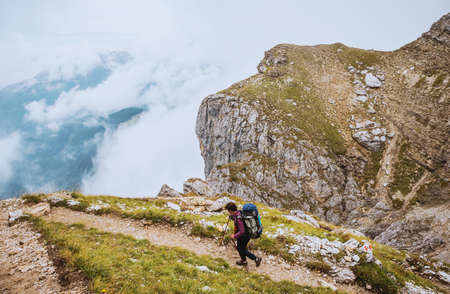1. Understanding Common U.S. Hiking Terrains
When hitting the trails in the United States, hikers encounter a wide range of terrains that each come with unique challenges and risks. Knowing what kind of ground youll be hiking on is key to preparing for your trip and staying safe. Here’s a look at some of the most common types of hiking terrain across popular American trails:
Rocky Paths
Rocky trails are widespread, especially in regions like the Appalachian Mountains and parts of the Rockies. These paths can be uneven, slippery when wet, and sometimes require scrambling over boulders or loose stones. Proper footwear and careful foot placement are essential to avoid ankle twists or falls.
Desert Landscapes
The Southwest—think Arizona, Utah, and Nevada—is famous for its desert hikes. Sandy soils, loose gravel, exposed rock faces, and little shade define these routes. Dehydration and heat exhaustion are real risks here, so carrying enough water and sun protection is crucial.
Forested Routes
Many popular trails wind through dense forests, such as those found in the Pacific Northwest or along the East Coast. Expect roots underfoot, damp leaves, mud after rain, and sometimes limited visibility due to thick foliage. Wet surfaces can be slick, making slips more likely.
Mountainous Areas
The U.S. is home to several mountain ranges with high-altitude trails—like the Rockies, Sierra Nevada, and Cascades. Hikers face steep inclines, sudden weather changes, loose scree, and sometimes snowfields even in summer. Altitude sickness can also be a concern at higher elevations.
Comparison Table: U.S. Hiking Terrains
| Terrain Type | Main Features | Primary Risks | Regions Found |
|---|---|---|---|
| Rocky Paths | Boulders, uneven ground | Ankle injuries, falls | Appalachians, Rockies |
| Desert Landscapes | Sandy soil, little shade | Heat exhaustion, dehydration | Southwest (AZ, UT, NV) |
| Forested Routes | Damp leaves, mud, roots | Slips, trips | Pacific NW, East Coast |
| Mountainous Areas | Steep slopes, altitude | Scree slides, altitude sickness | Sierra Nevada, Rockies |
This variety means every trail has its own set of challenges. Being familiar with these terrains helps you plan ahead for safer adventures on America’s beautiful hiking trails.
2. How Terrain Influences Injury Risks
Understanding the Hazards of Different Terrains
When hiking in the U.S., the landscape can change fast—from rocky mountain trails to muddy forest paths. Each type of terrain brings its own set of injury risks. Knowing what to expect can help you stay safe on your next adventure.
Common Terrain Challenges and Their Impact
| Terrain Feature | How It Increases Risk | Common Injuries |
|---|---|---|
| Uneven Surfaces | Makes it easy to lose balance or misstep, especially when distracted by scenery. | Ankle sprains, twisted knees, falls leading to scrapes and bruises |
| Elevation Changes (Steep Ascents/Descents) | Puts extra strain on joints and muscles; increases fatigue and risk of slipping. | Knee injuries, muscle strains, slips causing head or wrist injuries |
| Loose Rocks & Gravel | Unstable footing makes slips and slides more likely. | Sprained ankles, falls with possible fractures or dislocations |
| Wet or Icy Conditions | Reduced traction turns easy walks into dangerous stretches. | Slips and falls, wrist injuries from breaking a fall, hypothermia if exposed too long |
The Importance of Being Prepared for U.S. Trails
American hiking trails vary greatly—from the icy slopes of Colorado’s Rockies to the root-laced tracks in Pacific Northwest forests. Adapting your plans and gear to the terrain is key. For example:
- Wear proper footwear: Sturdy boots with good grip help prevent slips and ankle twists.
- Use trekking poles: These add stability on loose or steep ground.
- Check trail conditions: Before heading out, look up recent trail reports for warnings about mud, ice, or rockslides.
- Pace yourself: Take breaks, especially on steep climbs or descents where fatigue can lead to mistakes.
Quick Tips for Safer Hiking Across Different Terrains in the U.S.
- If you’re new to rocky trails, start slow and watch your step—loose stones are a common cause of rolled ankles.
- On wet or icy paths, shorten your stride and keep your center of gravity low to maintain balance.
- Always check the weather before you go—rain can turn a safe trail into a slippery hazard within hours.

3. Regional Hazards: What to Watch Out For
Understanding Terrain-Specific Dangers Across the U.S.
The United States is home to an incredible variety of hiking terrains—from lush rainforests in the Pacific Northwest to high-altitude trails in the Rockies and sun-baked deserts in the Southwest. Each region comes with its own unique set of risks, and knowing what to expect can help keep you safe on the trail. Below is a breakdown of common terrain-based hazards found in different parts of the country and the injuries they’re most likely to cause.
Common Regional Hazards and Associated Injuries
| Region | Typical Terrain Hazard | Common Injuries |
|---|---|---|
| Pacific Northwest | Slippery moss-covered rocks and roots due to frequent rain | Ankle sprains, slips, falls, twisted knees |
| Rocky Mountains | Loose shale, scree slopes, steep rocky paths | Falls, wrist fractures, knee injuries, abrasions |
| Southwest (Deserts) | Unstable sand, loose gravel, cacti, sudden drop-offs | Ankle twists, puncture wounds, dehydration-related issues |
| Southeast (Appalachians) | Muddy trails, slippery leaves, exposed tree roots | Knee injuries, slips, strains from uneven footing |
| Northeast (Adirondacks & Whites) | Slick granite slabs, stream crossings, icy patches (even late spring) | Head bumps, broken wrists, hypothermia from cold water exposure |
Pointers for U.S. Hikers by Region
- Pacific Northwest: Waterproof boots with good traction are essential. Watch your step when crossing mossy logs or rocks—take it slow and use trekking poles if needed.
- Rockies: Test loose rock with your foot before putting your weight down. Descend slowly on scree slopes and consider gloves to protect your hands during a fall.
- Southwest: Carry extra water and be aware of heat exhaustion signs. Wear long pants to protect against cactus spines and always check footing on sandy or gravelly trails.
- Southeast: Muddy conditions call for boots with deep lugs. Pay attention to leaf-covered roots that can be hidden slip hazards.
- Northeast: Traction devices may be necessary even in shoulder seasons. Take care on wet granite and watch for fast-moving streams after rain.
Stay Informed Before You Go!
No matter where you hike in the U.S., checking local trail conditions and being aware of region-specific terrain challenges will help you avoid common injuries—and make your adventure safer and more enjoyable.
4. Essential Gear and Preparedness
When it comes to hiking in the U.S., being well-prepared is more than just a good idea—it’s a must for your safety, especially since different terrains can mean different risks. Here’s a quick guide to choosing the right gear and getting ready for your next adventure, with tips that match what American hikers commonly use and trust.
Choosing the Right Gear for Different Terrains
| Terrain Type | Recommended Gear | Why It Matters |
|---|---|---|
| Rocky Trails | Sturdy hiking boots with ankle support, trekking poles | Helps prevent ankle injuries and gives stability on uneven surfaces |
| Muddy or Wet Trails | Waterproof boots, moisture-wicking socks, gaiters | Keeps feet dry and reduces slip risk |
| Desert Terrain | Wide-brim hat, sunglasses, sunscreen, hydration pack | Protects from sun exposure and dehydration |
| Mountainous/High Elevation | Layered clothing, windbreaker, map/compass or trail app | Keeps you warm and helps with navigation in changing weather |
| Forested Areas | Bug spray, long sleeves/pants, bear spray (if needed) | Prevents bug bites and offers wildlife protection where necessary |
The American Hiker’s Must-Haves
- Sturdy Boots: U.S. hikers swear by high-quality boots that offer good grip and ankle support for all kinds of terrain.
- Trekking Poles: These aren’t just for steep climbs—many Americans use them on flat trails too, as they help with balance and reduce strain on joints.
- Trail Apps: Popular apps like AllTrails or Gaia GPS help you stay on track and share real-time updates about trail conditions.
- Hydration Systems: Many hikers prefer hydration packs over water bottles for hands-free sipping during long hikes.
- Sunscreen & Insect Repellent: Essential almost everywhere in the U.S., given the variety of climates.
- Packed Snacks & Emergency Items: Energy bars, a small first aid kit, and a headlamp are always smart additions.
Packing Tips for Safety and Comfort
- Check weather forecasts before heading out—conditions can change fast!
- If you’re exploring unfamiliar areas, let someone know your route.
- Packing light is good, but don’t skip essentials like extra socks or rain gear.
- A printed map is handy even if you’re using an app—phones can lose signal or battery.
- Remember: public lands have their own rules. Some places require bear-proof containers or have restrictions on fires. Double-check before your trip!
Your Next Step: Match Your Prep to the Trail Ahead!
The better you prepare with the right gear for your chosen terrain, the safer—and more enjoyable—your hike will be. American trails are incredibly diverse, so always tailor your packing list to where you’re headed!
5. Tips for Staying Safe on the Trail
Practice Leave No Trace Principles
One of the best ways to stay safe and protect America’s beautiful natural spaces is by following Leave No Trace principles. This means packing out your trash, respecting wildlife, and leaving what you find. These habits not only keep you safe but also help preserve trails for everyone.
Stick to Marked Trails
In the U.S., marked trails are designed with your safety in mind. They avoid hazardous terrain and are regularly maintained. Going off-trail might seem adventurous, but it increases your risk of getting lost, encountering unstable ground, or disturbing fragile ecosystems.
| Marked Trails | Unmarked Terrain |
|---|---|
| Clearly signed paths | No signage or guidance |
| Regular maintenance | Hidden hazards (holes, loose rocks) |
| Easier rescue access | Difficult to locate if lost |
| Lower impact on environment | Possible damage to plants/wildlife |
Recognize Early Signs of Injury
Pain, swelling, blisters, or unusual fatigue are all warning signs that something could be wrong. It’s important to pay attention to your body and address small issues before they turn into big problems. Stop and rest if you need to. Carry a basic first aid kit so you can treat minor injuries right away.
Common Early Injury Signs and What to Do
| Sign | What To Do |
|---|---|
| Soreness or pain in joints/muscles | Take breaks, stretch, hydrate, adjust pace |
| Blisters forming on feet | Apply moleskin or bandages early, change socks if damp |
| Dizziness or headache | Rest in shade, drink water, eat a snack |
| Numbness/tingling in hands or feet | Stop activity, warm up affected area, monitor closely |
Be Prepared for U.S. Terrain Challenges
The U.S. has incredibly diverse landscapes—from rocky mountains and sandy deserts to muddy forests. Research your trail ahead of time so you know what footwear and gear are best. Check the weather forecast and always let someone know where you’re going.


